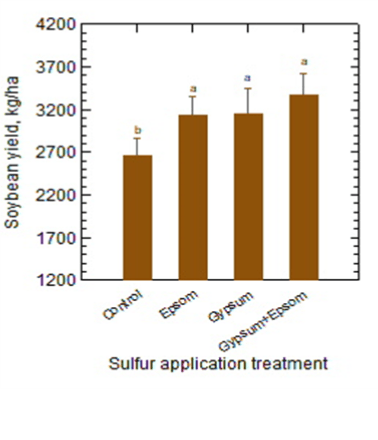Dana Rushovich and Ray Weil
Graduate Student and Professor
Department of Environmental Science and Technology
Sulfur is one of the six macronutrients that plants need for growth in addition to nitrogen (N), potassium (K), phosphorus (P), sulfur (S), calcium (Ca), and magnesium (Mg). Sulfur is taken up in similar quantities to P, but has widely been ignored as a part of farmer’s routine nutrient management for several reasons. Historically, S was applied routinely as part of organic amendments such as manure and compost and as an “impurity” in common fertilizers. Until the implementation of the amendments to the Clean Air Act in 1990, S was supplied in sufficient quantities through atmospheric deposition and mineralization of organic S in soils. However, with today’s higher yield agriculture, decreased atmospheric deposition and purified synthetic fertilizers, soils in the mid-Atlantic are becoming widely deficient in S.
Sulfur works closely with nitrogen in grain legume (soybean, bean, pea, peanuts) production. It is essential for nitrogen fixation and protein and oil synthesis. Sulfur is a key component of sulfur containing amino acids (SCAA) cysteine and methionine which are necessary for all non-ruminant animals (people included) to utilize proteins. These amino acids often limit the feed and food value of grain legumes. Grain legumes are second only to grains as the most widely grown crop worldwide and serve as a main protein source for many of the world’s populations as well as non- ruminant animals. Humans (and chickens) cannot synthesize methionine and cysteine and therefore must get it from dietary sources.
Responses in both yield and protein quality (amino acid composition) are most likely in sandy textured soils. However, finer textured soils will also likely become deficient in the coming decades. Sandy soils tend to be low in S because they have little anion exchange capacity (sulfate is held by iron coatings on soils), low organic matter (S is part of soil organic matter and is released during decay much like nitrogen is) and rate of leaching (S leaches away as sulfate anions).
A preliminary survey of MD soybeans by the Weil lab in the Department of Environmental Science and Technology found a wide range of S content and N/S ratios in the seed suggesting that many soils, especially the sandy soils on the eastern shore would be responsive to improved S management. A ratio of nitrogen to sulfur in the seeds greater than about 20 to 1 is often the best indication of sulfur deficiency. The range of seed compositions suggests that not all soybeans are alike in their feed or food value, even if their total protein content (or total N content) is similar.

2017 Soybean S Fertilization Trials
In 2017, soybean field trials were conducted at the Central Maryland Research and Education Center at Beltsville. A randomized split plot design with four treatments and 3 replicates per site was used. The four treatments were (1) Gypsum broadcast at time of planting at 500 lbs/acre (2) Epsom applied as a foliar spray at first flowering at a rate of 77 lbs Epsom salts in 30 gallons of water. (3) Combined Epsom and Gypsum (4) Control. Soybean yield measurements were taken with combine and seed samples were analyzed for total S by Inductively coupled Plasma Atomic Emission Spectroscopy (ICP-AES) and for amino acid content.
The results of the 2017 soybean trials showed that on the most responsive sites, S fertilization can lead to about a 15% yield increase and an almost doubling in the essential sulfur-containing amino acid content (Figures 2 and 3).
This year we are repeating the same soybean trials. We also expanded to include studies using edible black bean (Phaseolus vulgarus) to determine if the similar results would be seen in grain legumes that are more commonly eaten directly by people, especially by vegetarians or poor people in developing countries.


We had two field sites for the black beans, one at the Beltsville Central Maryland Research and Education Facility and one at the Upper Marlboro facility. The Upper Marlboro field has a finer textured soil than the Beltsville site. We had four treatments and six replicates at the Beltsville facility and five at the Upper Marlboro facility. Preliminary data from Beltsville shows that the gypsum treatments (G) had an effect on black bean yield, but the Epsom treatments (E) did not have a significant effect on yield.
Standard soil tests used in Maryland (Mehlich-3 extraction) are not thought to be very predictive of where S is needed. We are working on evaluating other soil tests for sulfur. At this time, we suggest that soybeans grown on loamy sand and sandy loam soils without recent manure additions are likely respond to sulfur applications in both yield and quality. Sulfur deficient soybeans generally appear lighter green in the upper canopy, but the symptoms may not be noticeable without a sulfur-fertilized comparison.

While there is currently no premium paid for quality, collaborating farmers’ fields with strip tests have shown an extra 150 to 400 kg/ha (3 to 8 bushels/acre) of soybeans with the application of a foliar spray of Epsom salt at first flowering. We tentatively recommend applying 36 lbs/acre Epsom salt (6 lbs S/acre) at first flowering. Rates as low as 12 lbs of Epsom salts have shown responses and rates as high as 77 lbs/acre Epsom salt (12 lbs S/acre) have also worked. During extremely hot and dry conditions in the summer of 2018 there was some indication that the highest rate (77 lbs/acre Epsom salt) may have caused additional drought stress.
